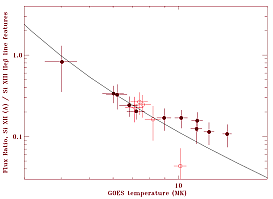Figure1

| Title: |
Temperature-sensitive Line Ratio Diagnostics based on Si Satellite-to-Resonance Line Ratios for 1s2-1snp Transitions |
|
| Authors: |
K. J. H. Phillips, J. Dubau, J. Sylwester, B. Sylwester, J. L. Culhane, G. A. Doschek, J. Lang
|
|
| Abstract: | Dielectronic satellite lines due to 1s2 n¢l¢- 1snp n¢l¢ (n=3, 4) transitions in Li-like Si (Si XII) occur at 5.818 Ǻ and 5.565 Ǻ, on the long wavelength side of the He-like Si (Si XIII) 1s2-1s3p and 1s2-1s4p lines at 5.681 Ǻ and 5.384 Ǻ respectively. They have been extensively observed with the RESIK crystal spectrometer on the Russian spacecraft CORONAS-F. As with corresponding satellites 1s2 nl - 1s 2p nl on the long-wavelength side of the Si XIII 1s2-1s2p resonance line, there is an inverse temperature dependence of the intensity ratio of the satellites to the He-like ion lines (Isat/IHe). New atomic data are used to calculate the Si XII satellite line intensities and thus the Isat/IHe ratio. RESIK observations of the ratio in solar flares, together with temperatures from the ratio of the two GOES X-ray channels, are compared with theoretical variation of the ratio with temperature. The good agreement indicates this to be a valuable temperature diagnostic for solar flares and laboratory plasmas such as tokamaks. There are implications for similar satellites in Fe line spectra which are observed with broad-band resolution by the RHESSI solar flare mission. |
| FULL VERSION-HTML | ||||
| Get pdf (152)kb | ||||
| Figures: |
Figure1 |
 |
||
Page created by Jaroslaw Bakala
(
jb@cbk.pan.wroc.pl)
Web Curator: Janusz Sylwester
(
js@cbk.pan.wroc.pl)